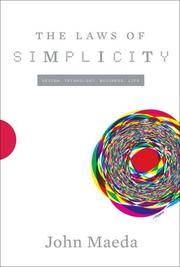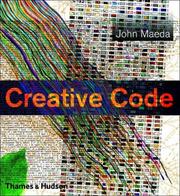| Listing 1 - 10 of 19 | << page >> |
Sort by
|
Book
ISBN: 0500282358 Year: 2000 Publisher: London Thames & Hudson
Abstract | Keywords | Export | Availability | Bookmark
 Loading...
Loading...Choose an application
- Reference Manager
- EndNote
- RefWorks (Direct export to RefWorks)
computer graphics --- Computer. Automation --- Graphic arts --- Architecture --- Art --- computer art [visual works] --- Maeda, John --- graphic design --- grafische vormgeving --- computerkunst

ISBN: 0262133547 Year: 1999 Publisher: Cambridge (Mass.) : MIT press,
Abstract | Keywords | Export | Availability | Bookmark
 Loading...
Loading...Choose an application
- Reference Manager
- EndNote
- RefWorks (Direct export to RefWorks)
Computer programming. --- Computer graphics. --- Programmation (Informatique) --- Infographie --- John Maeda ; foreword by Paola Antonelli --- computergrafiek --- computers --- kunst en technologie --- nieuwe media --- multimedia --- computerdesign --- internet --- interactiviteit --- design --- grafisch design --- grafisch ontwerp --- cyberspace --- Maeda John --- DBN --- 766.02 --- 791.5 --- Computer graphics --- Computer programming --- Computers --- Electronic computer programming --- Electronic data processing --- Electronic digital computers --- Programming (Electronic computers) --- Coding theory --- Automatic drafting --- Graphic data processing --- Graphics, Computer --- Computer art --- Graphic arts --- Engineering graphics --- Image processing --- Programming --- Digital techniques

ISBN: 9780262134729 0262134721 9780262278874 0262278871 1429412925 9781429412926 1282098063 9781282098060 9786612098062 6612098066 Year: 2006 Publisher: Massachusetts The MIT Press
Abstract | Keywords | Export | Availability | Bookmark
 Loading...
Loading...Choose an application
- Reference Manager
- EndNote
- RefWorks (Direct export to RefWorks)
This title presents ten laws of simplicity for business, technology, and design that teach us how to need less but get more. Finally, we are learning that simplicity equals sanity. We're rebelling against technology that's too complicated, against DVD players with too many menus, and software accompanied by 75-megabyte "read me" manuals. The iPod's clean gadgetry has made simplicity hip. But sometimes we find ourselves caught up in the simplicity paradox: we want something that's simple and easy to use - but also does all the complex things we might ever want it to do. In "The Laws of Simplicity", John Maeda offers guidelines, ten laws for balancing simplicity and complexity in business, technology, and design - for needing less and actually getting more. Maeda - a professor in MIT's Media Lab and a world-renowned graphic designer - explores the question of how we can redefine the notion of "improved" so that it doesn't always mean something more, something added on. Maeda's first law of simplicity is "Reduce." It's not necessarily beneficial to add technology features just because we can. And the features that we do have must be organized (Law 2) in a sensible hierarchy so users aren't distracted by features and functions they don't need. But simplicity is not less just for the sake of less. Skip ahead to Law 9: "Failure: Accept the fact that some things can never be made simple." Maeda's concise guide to simplicity in the digital age shows us how this idea can be a cornerstone of organizations and their products - how it can drive both business and technology. We can learn to simplify without sacrificing comfort and meaning, and we can achieve the balance described in Law 10. This law, which Maeda calls "The One," tells us: "Simplicity is about subtracting the obvious, and adding the meaningful."
Systems engineering. --- Systems engineering --- 745.01 --- computers --- design --- eenentwintigste eeuw --- eenvoud --- grafische vormgeving --- nieuwe media --- productdesign --- productontwikkeling --- technologie --- Engineering systems --- System engineering --- Engineering --- Industrial engineering --- System analysis --- Design and construction --- Trendwatching --- 770.6 --- Maeda, John --- minimalisme --- vormgeven --- productdesign, filosofie, esthetiek en kritiek --- 766.07 --- Computerkunst ; technologie in de kunst --- Digitale grafische vormgevers ; 2006 ; John Maeda --- Digitale kunsten ; vrije en toegepaste ; theorie --- Maeda, John °1966 (°Seattle, Verenigde Staten)
Book
ISBN: 9780262134721 Year: 2006 Publisher: Cambridge, Mass. The MIT Press
Abstract | Keywords | Export | Availability | Bookmark
 Loading...
Loading...Choose an application
- Reference Manager
- EndNote
- RefWorks (Direct export to RefWorks)

ISBN: 0500285179 Year: 2004 Publisher: London Thames and Hudson
Abstract | Keywords | Export | Availability | Bookmark
 Loading...
Loading...Choose an application
- Reference Manager
- EndNote
- RefWorks (Direct export to RefWorks)
Computer art --- Computer graphics --- Digital art --- Maeda, John --- Themes, motives.
Book
ISBN: 9780399564420 039956442X 9780593086322 0593086325 Year: 2019 Publisher: [New York] Portfolio//Penguin
Abstract | Keywords | Export | Availability | Bookmark
 Loading...
Loading...Choose an application
- Reference Manager
- EndNote
- RefWorks (Direct export to RefWorks)
"John Maeda is one of the world's preeminent interdisciplinary thinkers on technology and design. In How to Speak Machine, he offers a set of simple laws that govern not only the computers of today, but the unimaginable machines of the future. Technology is already more powerful than we can comprehend, and getting more powerful at an exponential pace. Once set in motion, algorithms never tire. And when a program's size, speed, and tirelessness combine with its ability to learn and transform itself, the outcome can be unpredictable and dangerous. Take the seemingly instant transformation of Microsoft's chatbot Tay into a hate-spewing racist, or how crime-predicting algorithms reinforce racial bias. How to Speak Machine provides a coherent framework for today's product designers, business leaders, and policymakers to grasp this brave new world. Drawing on his wide-ranging experience from engineering to computer science to design, Maeda shows how businesses and individuals can identify opportunities afforded by technology to make world-changing and inclusive products--while avoiding the pitfalls inherent to the medium"--
Machine theory --- Product design --- Computer logic --- Computer algorithms --- Electronic data processing --- Social aspects
Book
ISBN: 2878112466 9782878112467 Year: 2004 Publisher: Paris: Thames and Hudson,
Abstract | Keywords | Export | Availability | Bookmark
 Loading...
Loading...Choose an application
- Reference Manager
- EndNote
- RefWorks (Direct export to RefWorks)
John Maeda est, dans le domaine du numérique, probablement le plus grand designer, professeur et artiste actuel. Tandis que son précédent ouvrage maeda@media, qui connut un immense succès, retraçait l'ensemble de son œuvre, Code de création permet aujourd'hui de découvrir une facette moins connue mais ô combien essentielle de ce créateur : son activité d'enseignant au sein du célèbre MIT Media Lab. John Maeda nous ouvre en effet pour la toute première fois les portes du mythique Aesthetics and Computation Group (ACG) qu'il dirigea pendant huit années et nous présente les travaux les plus passionnants et innovateur de ses étudiants, dont la plupart jouissent désormais d'une réputation internationale. Très peu de leurs recherches, exercices et œuvres ayant filtré au-delà des murs du laboratoire, ce livre constitue un véritable événement, un formidable voyage au cœur de la création fondée sur le code. L'ouvrage, entièrement conçu par Maeda lui-même, s'organise autour de thèmes qui reflètent parfaitement les sujets et interrogations phares du design numérique actuel : la visualisation de l'information, la typographie, l'abstraction, l'interaction, l'enseignement. Chaque partie est accompagnée de courts essais très personnels signés de jeunes noms incontournables de la création numérique comme Casey Reas, David Small, Yugo Nakamura, Golan Levin, Joshua Davis ou encore Gillian Crampton Smith. Cette riche anthologie des travaux nés des esprits les plus inventifs d'un champ en pleine expansion permet d'entrevoir comment, à l'avenir, la création numérique pourra s'intégrer humainement dans nos vies et notre culture. Mariant avec génie science et art, John Maeda contribue par son enseignement original, son talent de créateur et sa vision personnelle du monde à une meilleure compréhension et à une plus grande richesse de l'expérience créatrice. (extrait de www.amazon.fr 21/11/2006)
Computer graphics. --- Computer art. --- Infographie --- Art par ordinateur --- Art --- Art numérique --- Création --- Enseignement --- Travaux d'étudiants --- Maeda, John
Book
ISBN: 9780262632447 Year: 2001 Publisher: Cambridge MIT Press
Abstract | Keywords | Export | Availability | Bookmark
 Loading...
Loading...Choose an application
- Reference Manager
- EndNote
- RefWorks (Direct export to RefWorks)
graphic design --- Computer. Automation --- computer programming --- computer art [visual works] --- computer drawings
Book
ISBN: 9780262015882 0262015889 9786613148155 0262295962 1283148153 9780262295963 026229494X Year: 2011 Publisher: Cambridge (Mass.) MIT press
Abstract | Keywords | Export | Availability | Bookmark
 Loading...
Loading...Choose an application
- Reference Manager
- EndNote
- RefWorks (Direct export to RefWorks)
Lessons for a new generation of leaders on teamwork, meetings, conversations, free food, social media, apologizing, and other topics.
Leadership. --- 766.07 --- 749.07 --- 766.01 --- Communicatiedesign ; grafisch ; elektronisch --- Communication Design ; 21ste eeuw ; John Maeda --- Kunst en economie ; wederzijdse innovatieve principes --- Management ; leiderschap ; nieuwe creatieve modellen --- Maeda, John °1966 (° Seattle, Washington, Verenigde Staten) --- Ability --- Command of troops --- Followership --- Gebruiksgrafiek ; grafische designers, reclamekunstenaars, typografen, illustrators A-Z --- Meubelontwerpers ; designers ; interieurarchitecten --- Gebruiksgrafiek ; theorie, filosofie, esthetica --- Leadership --- E-books --- Management. --- Administration --- Industrial relations --- Organization
Book
ISBN: 9780262349628 0262349620 9780262038881 0262038889 9780262539487 Year: 2020 Publisher: Cambridge, Mass. The MIT Press
Abstract | Keywords | Export | Availability | Bookmark
 Loading...
Loading...Choose an application
- Reference Manager
- EndNote
- RefWorks (Direct export to RefWorks)
How inclusive methods can build elegant design solutions that work for all.Sometimes designed objects reject their users: a computer mouse that doesn't work for left-handed people, for example, or a touchscreen payment system that only works for people who read English phrases, have 20/20 vision, and use a credit card. Something as simple as color choices can render a product unusable for millions. These mismatches are the building blocks of exclusion. In Mismatch, Kat Holmes describes how design can lead to exclusion, and how design can also remedy exclusion. Inclusive design methods--designing objects with rather than for excluded users--can create elegant solutions that work well and benefit all.Holmes tells stories of pioneers of inclusive design, many of whom were drawn to work on inclusion because of their own experiences of exclusion. A gamer and designer who depends on voice recognition shows Holmes his "Wall of Exclusion," which displays dozens of game controllers that require two hands to operate; an architect shares her firsthand knowledge of how design can fail communities, gleaned from growing up in Detroit's housing projects; an astronomer who began to lose her eyesight adapts a technique called "sonification" so she can "listen" to the stars.Designing for inclusion is not a feel-good sideline. Holmes shows how inclusion can be a source of innovation and growth, especially for digital technologies. It can be a catalyst for creativity and a boost for the bottom line as a customer base expands. And each time we remedy a mismatched interaction, we create an opportunity for more people to contribute to society in meaningful ways.
Design --- Social integration --- Marginality, Social --- 770.6 --- 614.3 --- productdesign --- ergonomie --- gebruiksvoorwerpen --- inclusive design --- inclusiviteit --- exclusion --- normality --- ability --- kunsteducatie --- Exclusion, Social --- Marginal peoples --- Social exclusion --- Social marginality --- Assimilation (Sociology) --- Culture conflict --- Social isolation --- Sociology --- People with social disabilities --- Inclusion, Social --- Integration, Social --- Social inclusion --- Belonging (Social psychology) --- Anthropology --- Anthropological aspects --- productdesign, filosofie, esthetiek en kritiek --- Product strategy --- Marginality, Social. --- Social integration. --- Anthropological aspects. --- design [discipline]
| Listing 1 - 10 of 19 | << page >> |
Sort by
|

 Search
Search Feedback
Feedback About UniCat
About UniCat  Help
Help News
News